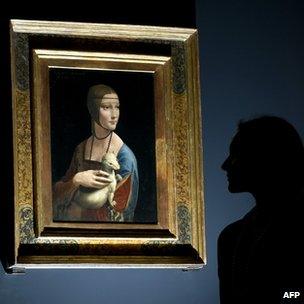How long do you need to look at a Leonardo?
- Published
- comments
Curator Luke Syson gives the BBC's Arts Editor, Will Gompertz, a guided tour of Da Vinci's only known portrait of a man, Portrait of a Musician
"Ah, this must be the 'bad footballers' haircuts from the 1970s' gallery," said a well-known art historian as he entered the first room of the Leonardo da Vinci exhibition at the National Gallery.
He then walked over to Leonardo's The Musician (1486), a painting that has never been seen in Britain before, and went nose-to-nose with the masterpiece with a mullet. And there he stayed for about 10 minutes, rocking backwards and forwards, before moving from side-to-side, and then finally stepping back four paces and eyeing up the small painting from distance. And then he repeated the exercise. Twice.
About half an hour later he strode into the next room where Leonardo's Lady With the Ermine (1488-90) and La Belle Ferronniere (1495-99) were hanging. "Ah," he declared, "this must be the 'foxy women' room."
This was last Sunday when television crews and art critics were allowed into the exhibition to preview and film the show. It was a great privilege, which reminded me of a bizarre episode in the ongoing story of Leonardo da Vinci and his priceless paintings.
Organisers say the exhibition is "the most complete display of Leonardo's rare surviving paintings" ever brought together in one place
Back in 2007, the Uffizi Museum in Florence lent his The Annunciation (1472-5) to the Tokyo National Museum for three months. The loan caused uproar in Italy. The Japanese, though, were delighted.
More than 10,000 visitors flocked to the museum every day to see the renaissance masterpiece. A number which, when divided by the museum's opening hours, equates to each visitor having about three seconds in front of the painting - barely long enough to say the artist's name, let alone enjoy the subtleties of his work.
Put another way, if each of the 800,000 or so visitors that went to see The Annunciation in Tokyo took, say, 20 minutes to have a decent look, the Japanese would have had to extend the loan period from the agreed three months to just over 95 years.
It is between these two extremes - the media's experience on Sunday and that of the Japanese Leonardo lovers - that most people going to the National Gallery's show will find themselves. So, once inside, what is the minimum amount of time that should be given to getting the most out of each of the nine masterpieces attributed to Leonardo da Vinci hanging in the exhibition?
With large crowds expected at the exhibition, will visitors be able to appreciate the paintings?
To find out I went to have a chat with the show's curator, Luke Syson. He told me that the museum has already put in some measures to help the viewing public by limiting numbers to 180 people per half an hour.
This will undoubtedly assist those who are able to get tickets (it is worth noting that 500 are being held back each day to be sold on a first-come-first-served basis) and frustrate those who cannot.
It is a difficult balance to strike and I think the museum has got it about right. In Syson's expert opinion you need "10 minutes, minimum" to properly explore each painting. He describes seeing a Leonardo "in the flesh" as an "extraordinary experience", one that cannot ever be reproduced.
"You really need to look," he says. "They are immensely rewarding."
The way in which the exhibition is arranged (some paintings are hung quite high and can been seen over people's heads) over several rooms should make a 10-minute view of each painting achievable for most.
Although the maths would suggest the closer you are to opening time, the better your experience will be. If 180 people are allowed in every 30 minutes and each takes at least 90 minutes (10 minutes on each of the nine paintings), plus some time to peruse all the exquisite drawings and comparison paintings also on show, and then have a mid-show sit down, things will start to become a bit of a squeeze by midday and might turn into a game of sardines by teatime.

The Lady with an Ermine by Leonardo da Vinci
The layout of the exhibition should help. The first room (otherwise known as "bad footballers' haircuts from the 1970s") is sparsely hung, with The Musician as the main focal point. The next room has two Leonardos and will cause some crowding, I'd imagine, as the Lady with Ermine is too captivating not to spend time with and she is hung bang in the centre of the room like a road block.
But once you're into the large, central gallery space (Room Four) where the two versions of The Virgin of the Rocks are hanging, the show opens out and elbowroom should be at less of a premium.
Another tip: the exhibition was originally commissioned by the Royal Academy's Charles Saumarez Smith, when he was director of the National Gallery. He suggested reading the catalogue first to help get most from time spent in the show. A less expensive option would be to go to the National Gallery's Leonardo website, external, which has plenty of useful content including a 20-minute film and a PDF of the exhibition guide.
And, if you are not lucky enough to see the show - or choose not to - there is always the rest of the National Gallery to explore. In it you will find one of the greatest collections of Western European art on the planet: great masterpieces in front of which you can stand and stare for hours. And, what's more, it won't cost you a penny.
Not in London? Many of its paintings are digitised on the BBC's Your Paintings website, along with a slideshow of the da Vinci works in public ownership in the UK.